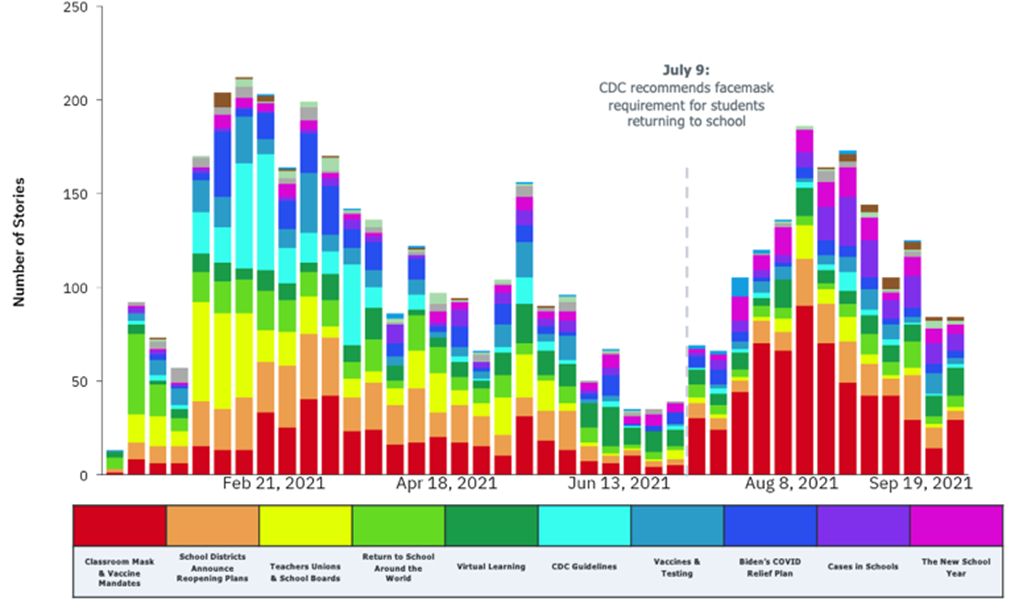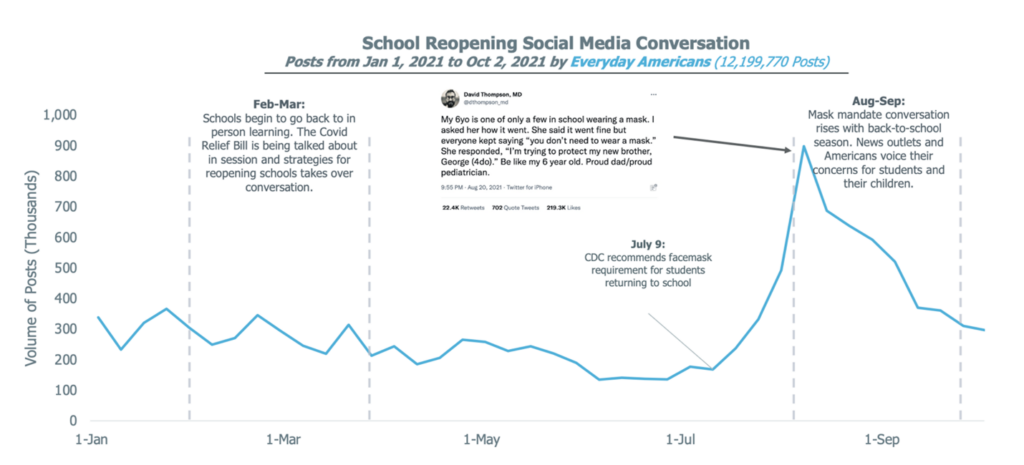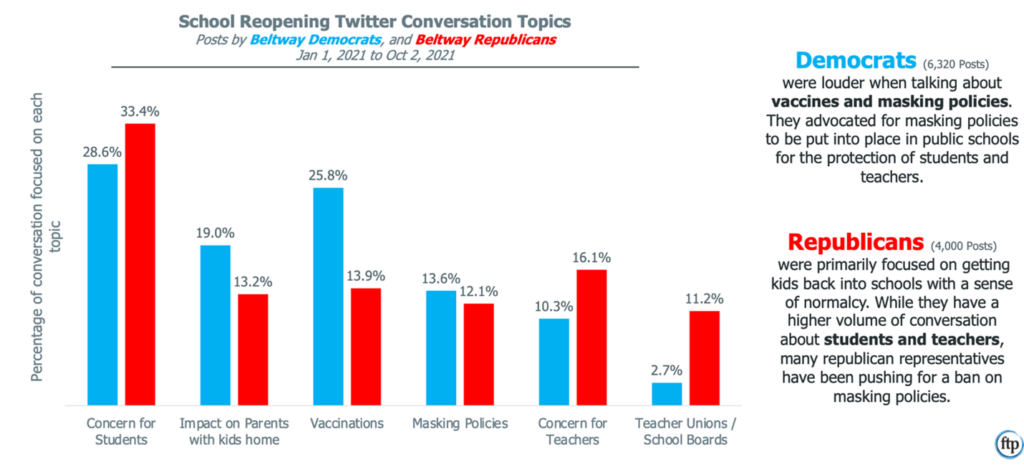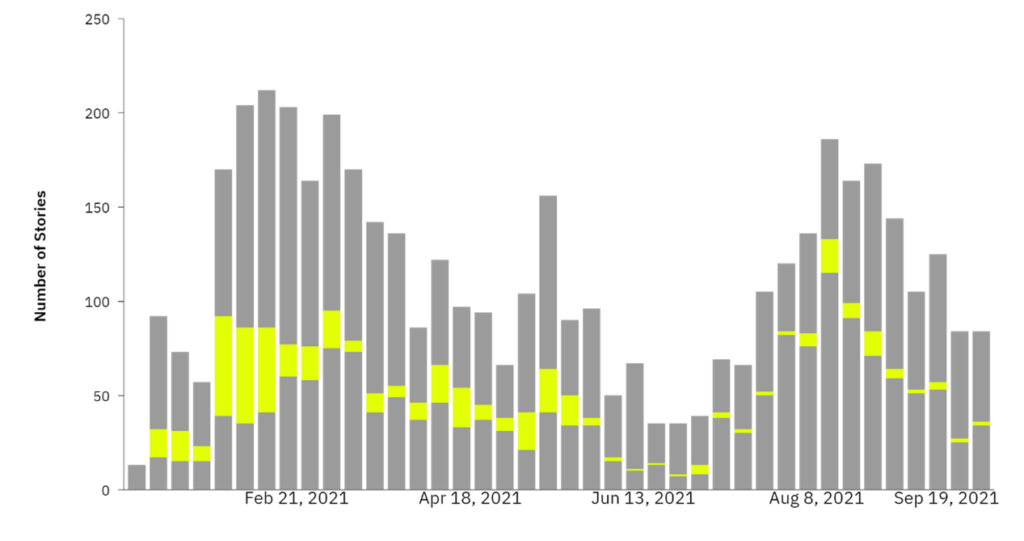As schools across the country near the end of their first full semester back, it is easy to forget the public debate over the return to in-person learning that occurred at the beginning of the year. The return to classrooms was a dominant topic within the broader COVID-19 recovery discussion and encompassed a variety of subthemes, ranging from the debate over mandates and public safety to union influence and curriculum reform.
The FTP Insights team conducted a full analysis of Twitter conversations and traditional media coverage from January 1 to October 2, 2021. We looked through over 6,550 individual news stories and 12.2 million tweets in search of major themes in coverage, as well as the changes in volume.
The debate over mask and vaccine mandates in schools drove the bulk of the conversation in the second half of the year, spiking volume that was otherwise subsiding as the summer arrived and there was agreement to return to classrooms.
Throughout the summer conversation, coverage surrounding the return to in-person learning began to lull. Volume jumped again on July 9 following the CDC announcement recommending mask requirements for students returning to school in the fall. The rise of the Delta variant only served to boost the topic further.

The social media conversation was dominated by key stories about children bringing COVID-19 back into their homes and passing it to parents, accompanied by opinions and debates over concern for students and families. There were also debates over the mask mandate bans implemented by governors such as Texas’ Greg Abbott and Florida’s Ron DeSantis.

Partisan divides emerged in the Beltway not on the decision to return to in-person learning, but on the specific safety protocols surrounding that return.
Aside from mask mandates, Republicans argued in favor of the benefits both to students and parents of returning to in-person learning, mostly highlighting the return to “normalcy” and the economic benefits of having parents who would otherwise be supervising their children return to the office. Democrats, on the other hand, focused on the Delta variant and voiced concerns over how it may spread quickly among schoolchildren, and advocated for more robust safety policies in classrooms.

The evolution of teachers unions’ hesitancy about returning to in-person learning strongly influenced the themes in coverage during the spring; less so after they came out in support of returning to classrooms.
As parents and local governments pushed for school re-openings in the spring, influential teachers’ unions were hesitant to return to classrooms, citing health concerns among their members despite being prioritized for vaccination. One of the most high-profile cases of this reluctancy among educators occurred in Chicago, where the city’s union threatened to strike in early February after the local government announced in-person learning would resume. San Francisco also gained volume in social media conversation when the city government sued its own school district after reopening plans were delayed.

Critical Race Theory (CRT) was central to coverage among Beltway publications, with a strong focus on the influence of teacher unions on curriculums
CRT surfaced as a subtheme within the broader school reopening discussion among traditional media sources. Notably, CRT was more central to the discussion among these publications, whereas they were more of an afterthought among major outlets outside Washington, D.C., such as The Wall Street Journal or the New York Times (see below). Interestingly, there was no meaningful conversation tying Critical Race Theory to school re-openings in our Twitter analysis.

Now that the CDC has authorized the use of COVID-19 vaccines for school-age children and talks of potential vaccine mandates for eligible students — which already exist in colleges — have surfaced, the FTP Insights team is keeping a close eye on how the broader in-person narrative evolves into the spring. Understanding the underlying issues within the opposition to mask mandates will be crucial as the country navigates the policies of the next phase in the fight against COVID-19.
This report was compiled through contributions from Caitlin Gallagher, Ethan Quan, and Santiago Olea. FTP is proud to provide ongoing research, trends, and expert opinion and insights to provide our clients with high level resources. You can reach our insights team for access to our full analysis: CGallagher@forbes-tate.com.
